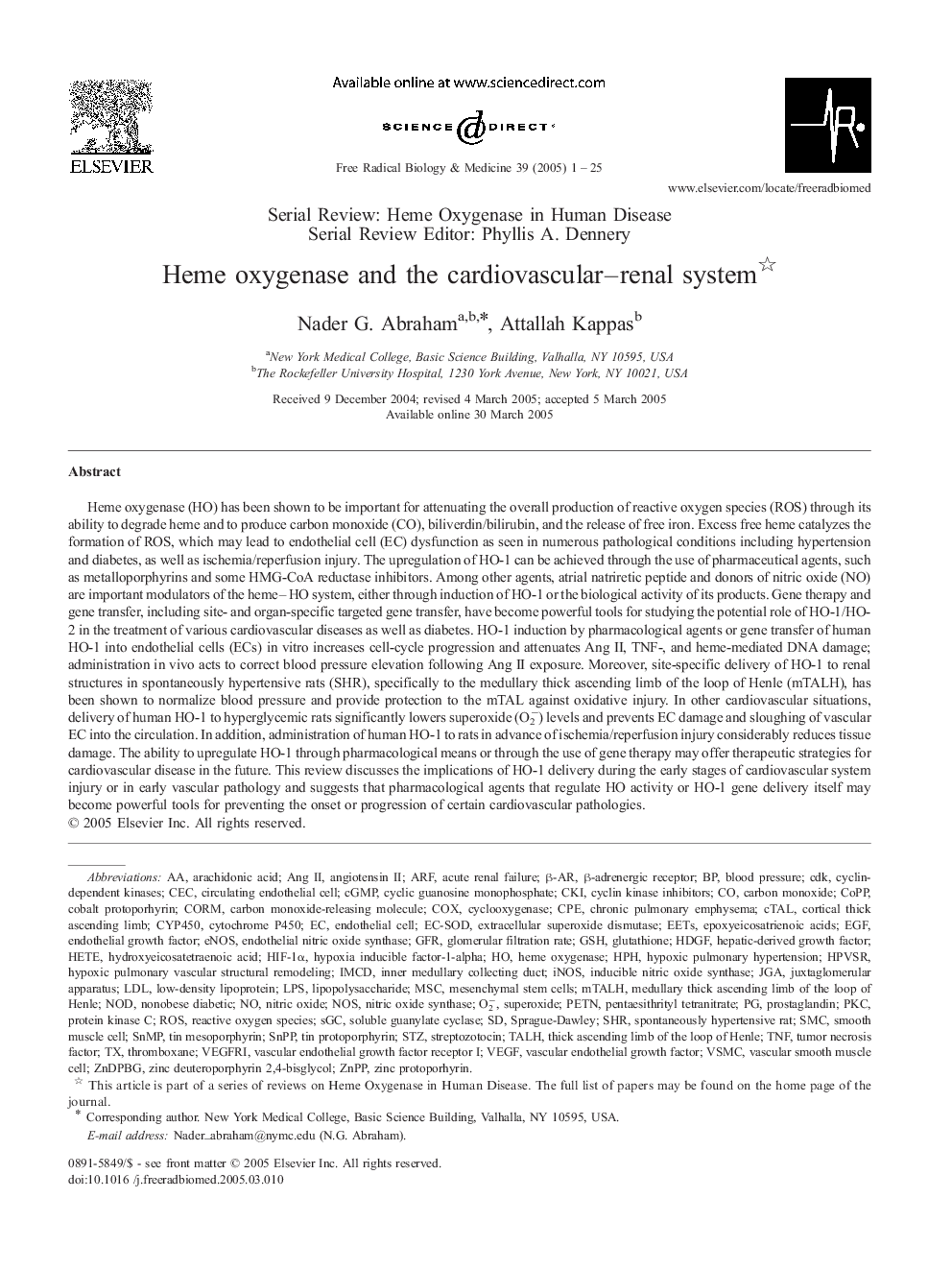| کد مقاله | کد نشریه | سال انتشار | مقاله انگلیسی | نسخه تمام متن |
|---|---|---|---|---|
| 10739233 | 1046868 | 2005 | 25 صفحه PDF | دانلود رایگان |
عنوان انگلیسی مقاله ISI
Heme oxygenase and the cardiovascular-renal system
دانلود مقاله + سفارش ترجمه
دانلود مقاله ISI انگلیسی
رایگان برای ایرانیان
کلمات کلیدی
VSMCCORMCoPPHDGFIMCDARFcGMPMSCCECGFRNOSGSHHPHiNOSSGCEETseNOSβ-ARPKCSTZHIF-1αCyclin kinase inhibitorsJGACDKEGFcTALNODLPSCOXTNFCYP450EC-SODPETNSMCCPETin mesoporphyrinZnPPSnMPCKIO2− - O2-ROS - ROSSnPP - SNPPcyclooxygenase - آنزیم سیکلواکسیژنازAngiotensin II - آنژیوتانسین دوstreptozotocin - استرپتوزوتوسینSprague-Dawley - اسپراگ داولیArachidonic acid - اسید آراشیدونیکepoxyeicosatrienoic acids - اسید اپوکسی اسیاتریتروئینhydroxyeicosatetraenoic acid - اسید هیدروکسی اسیستاترونیکthromboxane - ترومبوکسیانSpontaneously Hypertensive Rat - خودآزمایی موش بالینیJuxtaglomerular apparatus - دستگاه JuxtaglomerularAng II - دومNonobese diabetic - دیابتی NonobeseTALH - سرماخوردگیCirculating endothelial cell - سلول اندوتلیال تومورSmooth muscle cell - سلول عضلانی صافVascular smooth muscle cell - سلول عضله صاف عروقیEndothelial cell - سلول های اندوتلیالMesenchymal stem cells - سلول های بنیادی مزانشیمیinducible nitric oxide synthase - سنتاز اکسید نیتریک القاییendothelial nitric oxide synthase - سنتاز اکسید نیتریک اندوتلیالSuperoxide - سوپر اکسیدextracellular superoxide dismutase - سوپر اکسید دیسموتاز خارج سلولیCytochrome P450 - سیتوکروم پی۴۵۰Soluble guanylate cyclase - سیکلاس گوانیلات حل کنندهShr - شریEndothelial growth factor - فاکتور رشد اندوتلیالVascular endothelial growth factor - فاکتور رشد اندوتلیال عروقیVascular Endothelial Growth Factor (VEGF) - فاکتور رشد اندوتلیال عروقی (VEGF)tumor necrosis factor - فاکتور نکروز تومورBlood pressure - فشارخونLow-density lipoprotein - لیپوپروتئین کم چگالی یا الدیال LDL - لیپوپروتئین کم چگالی(کلسترول بد)lipopolysaccharide - لیپوپلی ساکاریدcarbon monoxide - منوکسیدکربنCarbon monoxide-releasing molecule - مولکول آزاد کننده مونوکسید کربنcyclic guanosine monophosphate - مونوفسفات گوانوزین چرخه ایAcute renal failure - نارسایی حاد کلیهGlomerular filtration rate - نرخ فیلتراسیون گلومرولیNitric oxide - نیتریک اکسیدnitric oxide synthase - نیتریک اکسید سنتازHETE - هفتهheme oxygenase - همگام اکسژنازHypoxic pulmonary hypertension - پرفشاری خون ریوی هیپوکسیProtein kinase C - پروتئین کیناز سیTin protoporphyrin - پروتپورپیرین قلعprostaglandin - پروستاگلاندینهاinner medullary collecting duct - کانال جمع آوری مدولاری داخلیcyclin-dependent kinases - کیناز وابسته به سیکلینGlutathione - گلوتاتیونReactive oxygen species - گونههای فعال اکسیژنβ-Adrenergic receptor - گیرنده β-adrenergic
موضوعات مرتبط
علوم زیستی و بیوفناوری
بیوشیمی، ژنتیک و زیست شناسی مولکولی
سالمندی
پیش نمایش صفحه اول مقاله

چکیده انگلیسی
Heme oxygenase (HO) has been shown to be important for attenuating the overall production of reactive oxygen species (ROS) through its ability to degrade heme and to produce carbon monoxide (CO), biliverdin/bilirubin, and the release of free iron. Excess free heme catalyzes the formation of ROS, which may lead to endothelial cell (EC) dysfunction as seen in numerous pathological conditions including hypertension and diabetes, as well as ischemia/reperfusion injury. The upregulation of HO-1 can be achieved through the use of pharmaceutical agents, such as metalloporphyrins and some HMG-CoA reductase inhibitors. Among other agents, atrial natriretic peptide and donors of nitric oxide (NO) are important modulators of the heme-HO system, either through induction of HO-1 or the biological activity of its products. Gene therapy and gene transfer, including site- and organ-specific targeted gene transfer, have become powerful tools for studying the potential role of HO-1/HO-2 in the treatment of various cardiovascular diseases as well as diabetes. HO-1 induction by pharmacological agents or gene transfer of human HO-1 into endothelial cells (ECs) in vitro increases cell-cycle progression and attenuates Ang II, TNF-, and heme-mediated DNA damage; administration in vivo acts to correct blood pressure elevation following Ang II exposure. Moreover, site-specific delivery of HO-1 to renal structures in spontaneously hypertensive rats (SHR), specifically to the medullary thick ascending limb of the loop of Henle (mTALH), has been shown to normalize blood pressure and provide protection to the mTAL against oxidative injury. In other cardiovascular situations, delivery of human HO-1 to hyperglycemic rats significantly lowers superoxide (O2â) levels and prevents EC damage and sloughing of vascular EC into the circulation. In addition, administration of human HO-1 to rats in advance of ischemia/reperfusion injury considerably reduces tissue damage. The ability to upregulate HO-1 through pharmacological means or through the use of gene therapy may offer therapeutic strategies for cardiovascular disease in the future. This review discusses the implications of HO-1 delivery during the early stages of cardiovascular system injury or in early vascular pathology and suggests that pharmacological agents that regulate HO activity or HO-1 gene delivery itself may become powerful tools for preventing the onset or progression of certain cardiovascular pathologies.
ناشر
Database: Elsevier - ScienceDirect (ساینس دایرکت)
Journal: Free Radical Biology and Medicine - Volume 39, Issue 1, 1 July 2005, Pages 1-25
Journal: Free Radical Biology and Medicine - Volume 39, Issue 1, 1 July 2005, Pages 1-25
نویسندگان
Nader G. Abraham, Attallah Kappas,